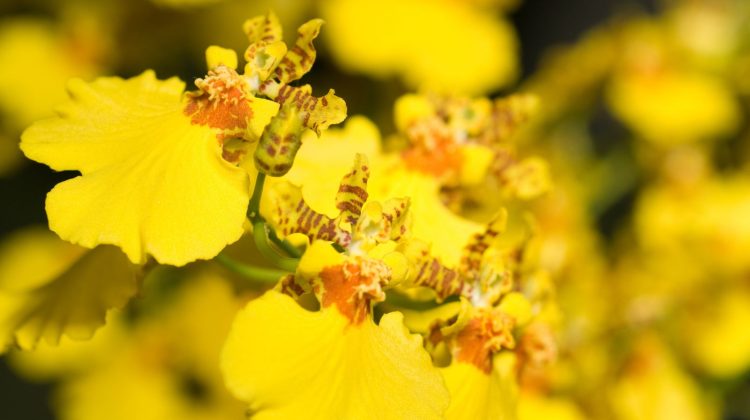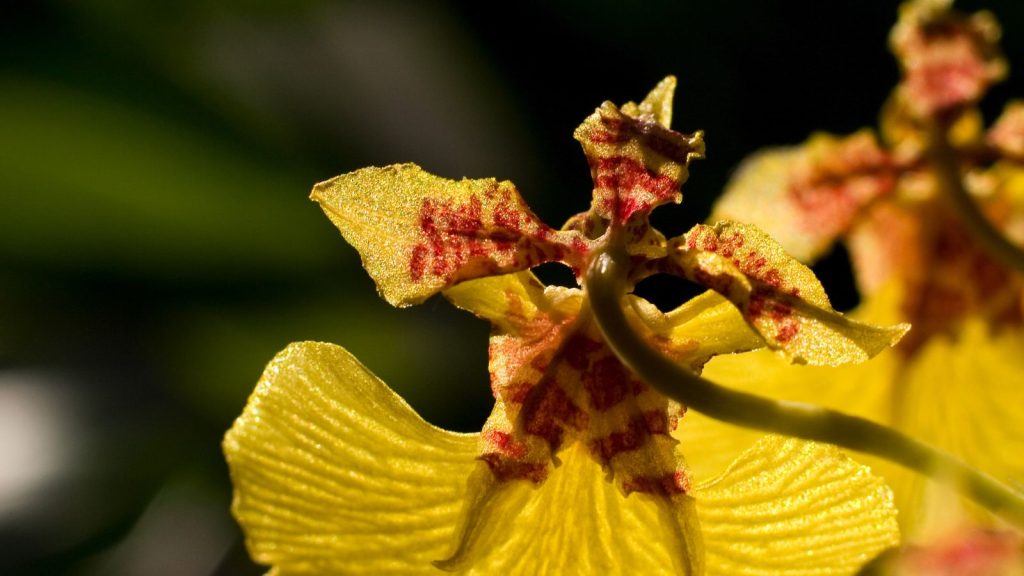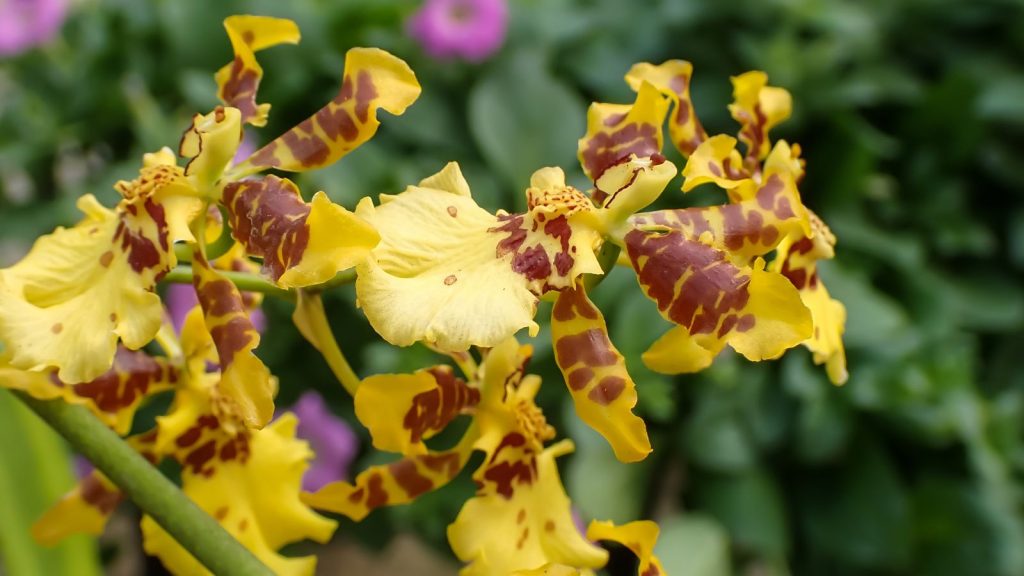
Oncidium orchids, often called the Dancing Lady Orchids, are celebrated for their prolific sprays of flowers that can bring a touch of the tropics to your home.
These stunning plants are comprised of a wide range of species and varieties, each with its own specific care requirements.
To grow lush oncidium orchids, paying attention to their particular needs for light, water, and orchid fertilizer is key.
Creating the ideal environment for your oncidium orchids involves selecting the right potting mix and maintaining proper humidity levels.
Oncidium orchids flourish with medium to high humidity and a mix that allows for good drainage yet retains sufficient moisture.
Remember, the success of your oncidium orchids at home relies on understanding and practicing diligent maintenance routines that mimic their natural habitat.
In this article, we'll cover
1. Lighting Is Key
For your Oncidium orchids to flourish, appropriate lighting is paramount.
Positioning them near a window where they are bathed in gentle morning rays or soft afternoon light is essential.
Consider a south or east-facing window draped with light-diffusing curtains to achieve this delicate balance.
- Be Vigilant: Watch for signs of too much sun, such as scorched leaves.
- Adjust Accordingly: If blooms are sparse, it may indicate a need for more light.
Remember, your Oncidium orchids crave well-lit surroundings without the harshness of the midday sun. Let the light embrace them in just the right amount to promote those stunning flowers.
2. Consistent Watering
Proper hydration is key to nurturing your Oncidium orchids.
It’s important to monitor the moisture level of their environment. When you notice the top inch of the potting mix feels dry, it’s time to water your plant.
Remember, while these orchids thrive with consistent moisture, they can suffer from too much of it. Their roots are particularly sensitive to excess water which can lead to root rot.
To ensure your Oncidium orchid’s health:
- Check potting medium regularly
- Water when top inch is dry
- Avoid over-saturating the soil
Tips for appropriate watering:
- Feel the soil before watering
- Use a pot with adequate drainage
- Water less frequently during cooler months
3. Humidity Matters

Maintaining the right humidity level is crucial for your Oncidium orchids, aiming for a comfortable range between 40% and 70%.
To achieve this, consider these strategies:
- Humidity Tray: Place your pot atop a tray filled with water and pebbles. This setup allows water to evaporate around your plant, boosting the surrounding air’s moisture.
- Humidifier: A more automated approach involves using a humidifier. It steadily infuses air with moisture, catering to your Oncidium’s needs with ease.
- Grouping Plants: By placing your orchids close to one another, they naturally create a more humid microclimate through their collective transpiration.
Remember, these tropical beauties thrive in a well-balanced humid environment. By keeping the air around them moist, you help mimic their natural habitat, leading to vibrant blooms and healthy growth.
4. Temperature Requirements
Oncidium orchids thrive when you mimic their preferred climate closely.
During the day, aim to keep your growing area within the 75°F to 85°F (24°C to 29°C) range. This temperature bracket is perfect to foster healthy growth and vivid blooms.
As the day transitions to night, these orchids benefit from a dip in temperature. A night setting around 60°F to 65°F (15°C to 18°C) is ideal.
It’s crucial to prevent abrupt shifts in temperature, as these can lead to the unfortunate outcome of buds falling off before they get the chance to open.
Maintaining these temperature conditions promotes a thriving environment for your oncidium orchids, ensuring a lush and vibrant display.
5. Fertilize Regularly
To ensure your Oncidium orchids thrive, develop a routine fertilization schedule.
During their growth phase, it’s crucial to provide nutrients every other week.
Opt for a balanced orchid fertilizer—for instance, a formula with equal parts nitrogen, phosphorus, and potassium (20-20-20) is ideal.
Remember to dilute the fertilizer to half its recommended concentration, which will deliver essential nutrients without overwhelming your plants.
Growing Season:
- Fertilize bi-weekly
- Use 20-20-20 fertilizer at half strength
As your orchid enters its dormancy phase in winter, it’s time to ease up on feeding.
Less frequent fertilization aligns with the orchid’s slowed need for nutrients. Scaling back will support the natural cycle of your plant without stunting its growth.
Winter Months: Reduce fertilization frequency
6. Air Circulation
Maintaining good airflow around your Oncidium orchids is key to keeping them healthy.
You’ll want to steer clear of stagnant air as it can lead to disease problems.
A strategic placement near an open window or the use of a gentle fan can do the trick.
- Position your orchid where it can enjoy a light breeze, but make sure to avoid strong winds that can harm its delicate structure.
- Consider a fan on a low setting to evenly distribute air, especially if your growing area lacks natural airflow.
- Regularly check that leaves and flowers aren’t being whipped around, as this suggests the current may be too strong.
By ensuring your Oncidium orchids are exposed to soft, but consistent air movement, you’ll be creating an ideal environment for them to thrive.
7. Repotting

Repotting your Oncidium orchid is key to maintaining a healthy plant.
Generally, it’s time for a new home for your orchid every two to three years, or when you observe that the current potting material is no longer firm or porous.
Here’s a simple guide on how to repot:
- Choose the right time: Spring or fall is ideal for this task.
- Select an appropriate container: Make sure it’s only slightly larger than the current one.
- Prepare the potting media: Grab an orchid-specific mix which ensures good drainage and air circulation around the roots.
When transitioning your orchid to its new pot, be gentle.
Trim away any damaged or rotting roots and settle the plant at the same depth it was previously. Fill in with your potting media and water sparingly to help your orchid adjust.
8. Pruning
When tending to your Oncidium orchids, it’s essential to approach pruning with a gentle touch.
Once the blooms have wilted, pay close attention to the color of the spike. If it begins to display shades of yellow or brown, that’s your cue to cut it back.
- Examine: Look for signs of new growth or potential rebloom on the spike.
- Wait: If the spike remains green, give it time as a new blossom might appear.
- Prune: When the spike’s color fades to brown, it’s safe to prune.
Pruning Steps:
- Inspect the spike for signs of aging or new growth.
- Prune only when the spike turns brown or yellow.
- Use sharp, sterilized scissors to make clean cuts.
9. Pest And Disease Management
When nurturing your Oncidium orchids, vigilance against pests is key.
You might encounter spider mites, scale, and mealybugs.
These little critters can be a nuisance, but managing them is straightforward. A gentle spray with insecticidal soap or neem oil usually does the trick.
For those sneaky fungal and bacterial issues, keeping a close eye on your plant will allow you to act quickly.
Each problem might need a tailored treatment, so identifying the issue early gives your orchids the best chance at bouncing back to health.
10. Patience And Observation

Cultivating Oncidium orchids in your home can be richly rewarding, but it demands your time and attentive care.
Every orchid is a unique individual with distinct preferences. You’ll succeed best when you tune into your orchid’s subtle cues.
- Watch for changes in leaf color or texture.
- Feel the potting medium to gauge moisture levels.
- Note how your orchid reacts to light exposures.
Over time, your close observation will reveal how slight adjustments in watering, lighting, and feeding can foster a more vibrant plant.
Your attentive care offers the greatest gift to your Oncidium orchid: a home where it can flourish.
Embrace the joy of this nurturing journey, and remember, your patience will be rewarded with the sight of those stunning blooms.
Leave a Reply